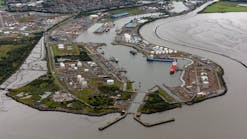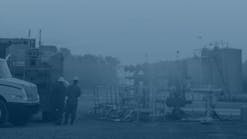OIL MOVEMENTS-CONCLUSION INTEGRATING OIL MOVEMENT AND DATA SYSTEMS BEEFS PROJECT BENEFITS
Myke King
Whitehouse Consulting
Southampton, U.K.
Automatic data reconciliation, yield reconciliation, and refinery information systems are important considerations in automating refinery oil movement and storage (OM&S) systems.
A number of practical examples will demonstrate the importance of integrating these information systems as opposed to using a stand-alone OM&S system.
Also important in implementing an integrated, automated OM&S scheme are the necessary changes in work functions and habits that will accompany the new System.
DATA RECONCILIATION
Data reconciliation is a well-established technique that uses redundant flow measurements. These multiple "opinions" of the true value are combined with reliability-weighting factors to estimate the most likely value. The greater the level of redundancy, the better the reliability of the estimated value (in this case, the overall mass balance).
If used over a substantial period (e.g., 24 hr), inventory information provides an accurate estimate of flow rates. Automatic reconciliation ensures early detection of metering errors and rapid diagnosis of the faulty measurements. It also prevents wasting limited maintenance resources to check measurements that are later found to be correct.
Automatic reconciliation can be used to generate optimal preventive maintenance schedules for instruments by either reducing the frequency of checks or providing proof that an instrument is persistently failing and should be replaced. In both cases, maintenance resources will be used more efficiently.
Achieving automatic data reconciliation is not simply a question of making tank inventories available to the reconciliation package, as the following example will illustrate.
Most offsites areas have a multiplicity of routings. This often means the same flowmeter can be used for several routings.
Such routings are often set up manually. Relying on an operator to accurately record the time a routine was changed has been proven unreliable. When routing changes are detected automatically, the flowmeter accumulation calculations can be adjusted accordingly. Otherwise, data reconciliation is unlikely to produce more accurate estimates of flow than do meter readings.
Refinery information systems, in general, are worth 20 cts/bbl of crude processed.
These benefits are largely based on the ability to generate timely, reliable mass and energy balances.
Even if only 10% of the achieved benefits are attributable to data reconciliation, and only half of these are attributable to the incorporation of OM&S data, then a 100,000 b/d refinery could save almost $400,000/year.
OIL LOSS
Two major sources of oil loss are the overestimation of imports and the underestimation of exports. OM&S systems can cross-validate many measurements related to these sources of error:
- Loading meters are automatically checked against tank levels.
- Statistical methods can be applied to check and calibrate meters.
Although most refineries use independent inspectors, they too are fallible. However, if an error is detected early and the inspector is challenged before the ship sails, it is usually possible to resolve the error. Detection after sailing, however, is rarely of practical value.
One refiner who relied heavily on third-party measurements saved $4 million/year by improving ship-to-shore reconciliation.
OM&S systems can also incorporate other functions that help control oil loss by such causes as evaporation from floating-roof tanks. For example, one refiner reduced refinery oil loss by 0.1%. Valuing this reduction (conservatively) as crude at $18/bbl, a 100,000 b/d refinery would save $650,000/year.
MAINTENANCE/INSPECTION
Most refiners use some form of automatic tank gauging (ATG) on a number of tanks. ATG systems can require frequent calibration, often for statutory fiscal purposes. The OM&S system can record calibration checks and use them to demonstrate whether individual gauges require a major overhaul or if checks can be executed less frequently.
One refiner exported the bulk of its products to its affiliates. There were no statutory or customer requirements that transfer volumes be checked by an independent inspector.
By upgrading the monitoring in the OM&S area, the refiner increased the confidence level of its metering and reduced its use of an inspector.
TAXES/CLAIMS
Fiscal arrangements vary from country to country. In some countries, taxes are paid on products as they leave the refinery. Measurements can be taken from bills of lading, custody transfer meters, or tank gauges. But in any case, overestimating volume will result in overpaying taxes.
In one refinery, a single incident, which probably could have been avoided with better monitoring, cost $200,000. Without the necessary historical data, however, the refiner was not in a strong position to convince the authorities of the error.
Another refiner was prone to claims that were costly to defend and reconcile. There was often no tangible evidence to assist in the defense of such false claims.
An OM&S system's improved record system would have, in this case, saved the refiner money.
YIELD RECONCILIATION
Reconciling actual yields against anticipated ones is only worth while if the refiner has confidence in both the measured and predicted values. The lack of such confidence will result in time consuming arguments about whether a deviation from target is real. The resulting losses in product yield will accumulate until the debate is resolved.
As mentioned previously, data reconciliation is more reliable when tankage data are incorporated. To improve confidence in the predicted yield, it is usually necessary to have some feedstock quality data.
Whitehouse Consulting is aware of at least two plants in which this was a major problem. In both cases, crudes were off loaded from tankers to coastal storage facilities. The storage tankage held heels from previous cargoes which contaminated the crude.
A similar situation existed in the refinery. Crude was received from the coast via pipeline, but often the refinery crude tank was feeding the crude distillation unit (CDU) while it was receiving crude. The situation was further complicated by a pipeline delay of several days, depending on pumping rates.
Automatic collection of tankage data from both tank farms, together with pipeline pumping rates and CDU feedrates, enabled the refiner to continuously calculate the mixture of crude types being processed. Using this as input to a CDU simulation model produced more reliable yield predictions.
As a result of similar yield predictions, one refiner was able, within 2 days, to identify an unexplained reduction in kerosine yield and diagnose the cause of the problem as a faulty stripping-steam meter. Without this tool, the refinery probably would not have spotted the problem for several months.
Another refiner similarly noted a more general problem with yields, identifying the cause as tray damage. The problem was not severe enough to be obvious without such monitoring and probably would not have been noticed until the next internal inspection of the column, which was scheduled for 18 months later.
As a result of monitoring, the unit was shut down earlier, and afterwards quickly returned to its normal operation.
COST REDUCTION
OM&S automation can be very expensive compared to processing projects. Additional valve actuators usually are needed where hand valves are in frequent use. And because of the distances involved, added power and signal cables can be a major contributor to cost.
A refiner also may have an inadequate ATG system. In one plant, the ATG system appeared functional when used manually, but frequent scanning by a monitoring system revealed many inaccuracies. Failure rates increased to unmanageable levels, making replacement of the system necessary.
OM&S automation costs can be reduced, however, without reducing benefits proportionally. A number of radio-based products can eliminate the need for signal cable. These typically use local power supplies, reducing power cable costs.
Although not generally accepted for control purposes, radio-based products are proven for monitoring. In some cases, the technology has been applied to on/off operation of valves-the main requirement of OM&S.
Portable data terminals also have been proven and several are available with radio links. Instructions can be relayed to field operators who then acknowledge receipt of the information and confirm that the required action has been completed. At least one European refiner is using portable terminals in such an application.
This approach is still subject to human error; the operator can act wrongly or wrongly assume that action has been taken already. The installation of devices such as valve-limit switches connected to a radio transmitter can prevent these types of errors.
Although the operator still must act, the system will not normally request changes that have already been made, nor is it likely that an operator error will go unnoticed by the system.
One cost-saving approach adopted by many refineries is to install an OM&S system limited to monitoring only. This method generally ca p lures a large portion of the benefits, but at a significantly lower cost.
INTEGRATION
Fig. 1 illustrates the flow of an integrated process information and planning system.
A refiner may be tempted to lower costs by installing small computers dedicated to basic functions. For example, many ATG systems incorporate strapping tables, alarm functions, etc. Such systems can create difficulties if the data are not readily available to other systems and users.
Many refinery functions require data from multiple sources. Monitoring product giveaway, for instance, requires:
- Quantity and timing of product exports (from oil accounting)
- Qualities (from the laboratory)
- Specifications (from the planners and laboratory)
- Economics (from the planners and process engineers).
Fig. 2 shows how blend automation justifies system integration. Realistically, OM&S automation is likely to be a major, complex project that can only be implemented stand-alone, or as a number of smaller projects. Experience, however, shows that more successful systems result from the detailed definition of the overall integration requirements before design of the OM&S portion is started.
OM&S uses data from multiple sources and supplies key data to other users, as shown in Fig. 1. Most personnel in the OM&S area require user interfaces to other applications.
The overall definition of these requirements will ensure that data can be transferred efficiently between applications, thus avoiding the proliferation of user interfaces.
In the refining industry, there are many examples of how the synergistic effect of true integration has produced benefits beyond those produced by the individual applications (Fig. 2).
MAKE OR BUY?
There is no complete package for OM&S automation, although some organizations are moving toward this. Installations still require a great deal of customizing.
It can be tempting to use this as an argument for developing a system in-house, particularly if the refiner has several sites where it can be applied. Such developments, however, should be approached with great caution.
One refiner spent the entire budget allocated for a full-site information system on only, the partial development of OM&S monitoring. The same system was replaced a few years later with one provided by a third party.
ORGANIZATIONAL IMPACT
One refiner who implemented only blend automation found that organizational work was needed before the system could be fully commissioned. In the former method, the planner determined the optimum blend formulation and instructed operations. The new method required the planner only to specify a schedule of blend volumes and grades. The package then performed all the functions under the control of operations personnel.
The duties of the planner changed from the routine calculation of recipes to consideration of higher-level aspects such as generating an optimal schedule. Adapting to such changes required significant personnel training and a subtle shift in policy concerning the quality of personnel employed in both the planning and offsites groups.
Although such situations appear trivial, they will occur throughout the refinery as personnel change from 'doing the job right' to 'doing the right job.' The required organizational change will usually take longer to implement than the technical aspects.
To ensure timely, successful commissioning of the system, the organizational changes need to be identified early. Likewise, system implementation should be planned parallel to the rest of the project.
Truly beneficial information systems do much more than automate routine tasks. If justified only on savings in administrative personnel, however, it is unlikely that the installation of such a system will be economically viable.
The importance of integrating automatic data reconciliation with refinery information and planning systems can be seen through the examples discussed in both articles in this series. Recognizing similar incidents in one's own refinery can help in justifying and implementing a worthwhile refinery OM&S automation project.
Copyright 1993 Oil & Gas Journal. All Rights Reserved.


